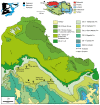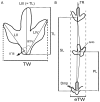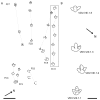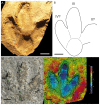Discriminating between medium-sized Tridactyl Trackmakers: tracking Ornithopod tracks in the base of the Cretaceous (Berriasian, Spain)
- PMID: 24303075
- PMCID: PMC3841126
- DOI: 10.1371/journal.pone.0081830
Discriminating between medium-sized Tridactyl Trackmakers: tracking Ornithopod tracks in the base of the Cretaceous (Berriasian, Spain)
Abstract
Background: Recent work on the Jurassic-Cretaceous transition of the Iberian Range (Spain) has opened a new window onto the interpretation of the trackmakers of some medium-sized tridactyl tracks. The ichnotaxon Therangospodus oncalensis has been described in the Huérteles Formation (Berriasian) and is one of the classical tracks from the area assigned to medium-sized theropods.
Methodology/principal findings: A review of the type locality of Therangospodus oncalensis (Fuentesalvo tracksite) and other tracksites from the Huérteles Formation (Berriasian) has yielded new information on the morphology, gait and trackmaker identity of the aforementioned ichnospecies. The new data suggest that the trackmaker is an ornithopod rather than a theropod on the basis of the length/width ratio, the anterior triangle length-width ratio, the short steps, the round to quadrangular heel pad impression and the probable manus impressions.
Conclusions/significance: T. oncalensis shows similarities with various tracks from the Berriasian of Europe assigned to Iguanodontipus. The ichnotaxonomical status of this ichnospecies is here considered as Iguanodontipus? oncalensis due to the current state of knowledge of the ichnotaxonomy of medium-sized ornithopod tracks. This reassessment of I? oncalensis also has two significant implications for the palaeoecology of the faunas during the deposition of the Huérteles Formation: 1- the high number and percentage of theropod tracks would be lower than previous papers have suggested. 2- the gregarious behaviour described in the type locality (Fuentesalvo) would be among ornithopods instead of theropods.
Conflict of interest statement
Figures















Similar articles
-
Manus track preservation bias as a key factor for assessing trackmaker identity and quadrupedalism in basal ornithopods.PLoS One. 2013;8(1):e54177. doi: 10.1371/journal.pone.0054177. Epub 2013 Jan 22. PLoS One. 2013. PMID: 23349817 Free PMC article.
-
Megalosauripus transjuranicus ichnosp. nov. A new Late Jurassic theropod ichnotaxon from NW Switzerland and implications for tridactyl dinosaur ichnology and ichnotaxomy.PLoS One. 2017 Jul 17;12(7):e0180289. doi: 10.1371/journal.pone.0180289. eCollection 2017. PLoS One. 2017. PMID: 28715504 Free PMC article.
-
Ichnotaxonomic review of large ornithopod dinosaur tracks: temporal and geographic implications.PLoS One. 2015 Feb 12;10(2):e0115477. doi: 10.1371/journal.pone.0115477. eCollection 2015. PLoS One. 2015. PMID: 25674787 Free PMC article.
-
The theropod furcula.J Morphol. 2009 Jul;270(7):856-79. doi: 10.1002/jmor.10724. J Morphol. 2009. PMID: 19206153 Review.
-
Pain in dinosaurs: what is the evidence?Philos Trans R Soc Lond B Biol Sci. 2019 Nov 11;374(1785):20190370. doi: 10.1098/rstb.2019.0370. Epub 2019 Sep 23. Philos Trans R Soc Lond B Biol Sci. 2019. PMID: 31544618 Free PMC article. Review.
Cited by
-
Classification of large ornithopod dinosaur footprints using Xception transfer learning.PLoS One. 2023 Nov 29;18(11):e0293020. doi: 10.1371/journal.pone.0293020. eCollection 2023. PLoS One. 2023. PMID: 38019896 Free PMC article.
-
A machine learning approach for the discrimination of theropod and ornithischian dinosaur tracks.J R Soc Interface. 2022 Nov;19(196):20220588. doi: 10.1098/rsif.2022.0588. Epub 2022 Nov 9. J R Soc Interface. 2022. PMID: 36349446 Free PMC article.
-
Hints of the early Jehol Biota: important dinosaur footprint assemblages from the Jurassic-Cretaceous boundary Tuchengzi Formation in Beijing, China.PLoS One. 2015 Apr 22;10(4):e0122715. doi: 10.1371/journal.pone.0122715. eCollection 2015. PLoS One. 2015. PMID: 25901363 Free PMC article.
-
Geometric morphometric analysis of intratrackway variability: a case study on theropod and ornithopod dinosaur trackways from Münchehagen (Lower Cretaceous, Germany).PeerJ. 2016 Jun 8;4:e2059. doi: 10.7717/peerj.2059. eCollection 2016. PeerJ. 2016. PMID: 27330855 Free PMC article.
-
Stat-tracks and mediotypes: powerful tools for modern ichnology based on 3D models.PeerJ. 2018 Jan 11;6:e4247. doi: 10.7717/peerj.4247. eCollection 2018. PeerJ. 2018. PMID: 29340246 Free PMC article.
References
-
- Moratalla JJ, Sanz JL, Jiménez S (1988) Multivariate analysis on Lower Cretaceous dinosaur footprints: discrimination between ornithopods and theropods. Geobios 21 (4): 395-408. doi:10.1016/S0016-6995(88)80042-1. - DOI
-
- Thulborn T (1990) Dinosaur tracks. London: Chapman and Hall. 410 pp.
-
- Lockley MG (1991) Tracking dinosaurs: A new look at an ancient world. Cambridge: Cambridge University Press. 238 pp.
-
- Dalla Vecchia FM, Tarlao A (2000) New dinosaur track sites in the Albian (Early Cretaceous) of the Istrian peninsula (Croatia). Part II. Paleontology. Memorie di Scienze Geologiche 52 (2): 227-292.
-
- Romilio A, Salisbury SW (2011) A reassessment of large theropod dinosaur tracks from the mid-Cretaceous (late Albian-Cenomanian) Winton Formation of Lark Quarry, central-western Queensland, Australia: A case for mistaken identity. Cretaceous Research 32: 135-142. doi:10.1016/j.cretres.2010.11.003. - DOI
Publication types
MeSH terms
LinkOut - more resources
Full Text Sources
Other Literature Sources

